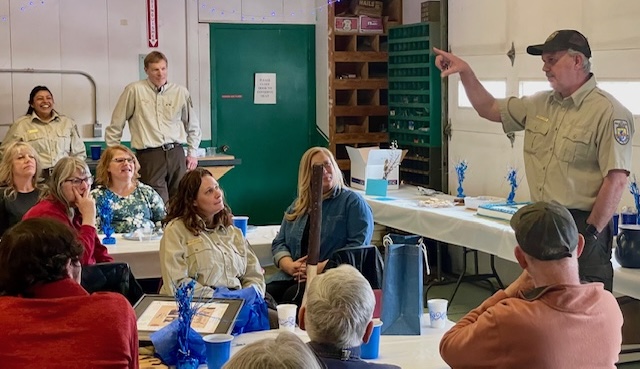Retiring wildlife refuge leader pushed for site to serve waterfowl and human visitors
By Patti Singer, Friends of the Iroquois National Wildlife Refuge
BASOM – High on Tom Roster’s to-do list when he arrived at Iroquois National Wildlife Refuge in November 2004 was getting Swallow Hollow Trail in shape and repairing the handicap-accessible boardwalk.
“That was a very big and impressive project that had a lot of hands in it,” Roster remembered. “And then we had a big celebration at the end. No sooner were we done with the celebration and cleaning up, and there was a wheelchair going down the boardwalk. That was kind of neat to see that.”
That initial project laid the groundwork for Roster’s tenure. His formal title is complex manager, but he’s known as the refuge manager. He worked with volunteers and the Friends of Iroquois National Wildlife Refuge on maintaining the 10,000-plus acres for wildlife conservation and human enjoyment and education.
Now, after more than 20 years at Iroquois NWR and more than 37 years with the U.S. Fish and Wildlife Service, Roster is retiring in April 2025 to find new adventures with his wife and family.
“I’ll be 59,” said Roster, who had planned this day since last fall. “I still have my health and can do a lot of other things. We can travel and do a lot of stuff before anything sets in. We’re still young.”
Many of those former Friends presidents, his colleagues and family threw Roster a retirement party on March 28 at the refuge to thank him for his service.
“Tom Roster has been a steady hand at the helm of the Iroquois refuge for several decades,” said Richard Moss, president of Friends of Iroquois National Wildlife Refuge, a nonprofit that supports the refuge. “His tenure spanned at least half a dozen Friends presidents, and he will be sorely missed.”
Roster grew up in northern Minnesota in an outdoors family. His older brother worked for the U.S. Fish and Wildlife Service. “He was doing all sorts of neat things and I thought that’s a great thing to do and get paid for.”
Roster has spent more than half his life with the U.S. Fish and Wildlife Service.
His first post was in 1986 as a summer volunteer at Red Rock Lakes National Wildlife Refuge in Lima, Montana. He worked as a student trainee at refuges in Wisconsin and Minnesota before earning his bachelor of science degree from the University of Minnesota. St. Paul, in 1990. His first job out of college was as a manager trainee in Sumner, Missouri. He moved to Oak Harbor, Ohio, San Diego, Calif., and Chincoteague, Va., before coming to Genesee County.
In those days, moving around was expected. “Get to know a lot of different things before you settle down to your own place,” Roster said. “So that’s what I did.”
Now Genesee County is home, even after his children have graduated from high school.
“The last graduation was 2019, and then we just decided to stick on here. There’s so much going on, a lot of fun and a lot great staff doing a lot of neat work, Friends and volunteers doing a tremendous amount of work and helping us out. The years flew by, and it’s been great.”
Roster said the volunteers help Iroquois NWR fulfill its mission of wildlife first as it has drawn about 100,000 visitors a year post-pandemic.
“There’s a lot of things that we do for the American people, whether it’s hunting, fishing, education programs, and that’s where folks like Friends and volunteers really help us out.”
Volunteers put in between 6,000 and 8,000 hours a year – about 200 40-hour work weeks. Roster said one volunteer has clocked 43,000 hours, and another had donated 28,000 hours. Their work includes mowing, trail work, education and fundraising.
“That is unbelievable that you’re working with people that have the compassion and the passion to do all of that work knowing they don’t get paid for it,” Roster said. “What they get out of it is self-satisfaction and the enjoyment that other people are getting something out of it. The people that have that selflessness and just being able to provide for other people and for the resources has been tremendous. … That deserves a big thank you for everything they’ve done over those years because that makes my life and my job a lot easier.”
Much of Roster’s 20 years at Iroquois NWR were spent at his desk, doing the paperwork and making the phone calls that ensured the refuge was at its best for waterfowl and human visitors.
He said he’ll miss coming to work on crisp fall mornings, and in spring being greeted by squawking geese, ducks and sandhill cranes.
He’ll also miss his staff and the Friends and volunteers — “all the things they do and all the camaraderie. We got projects done and provided for the visitors and resources. The biggest part will be missing those folks.”






























































